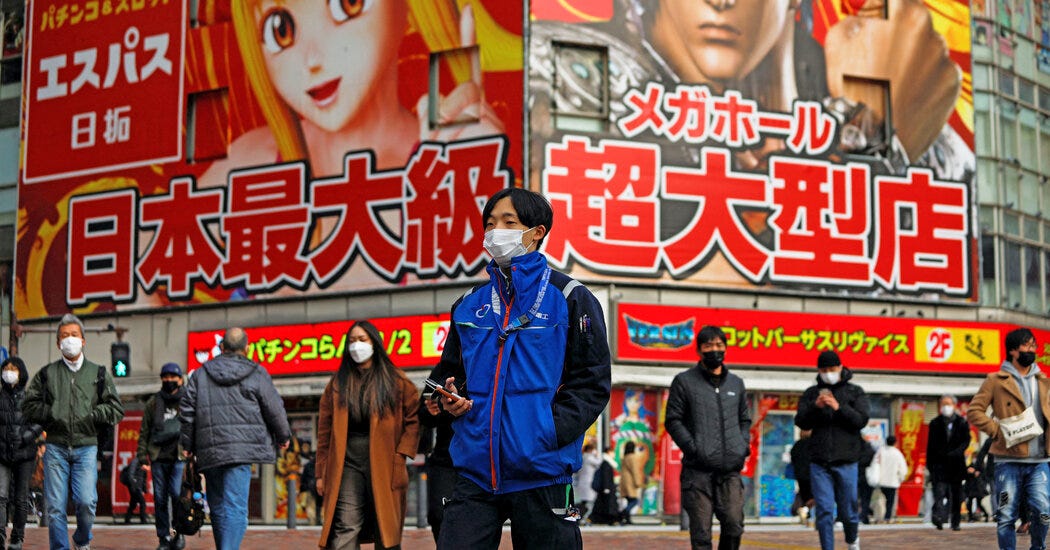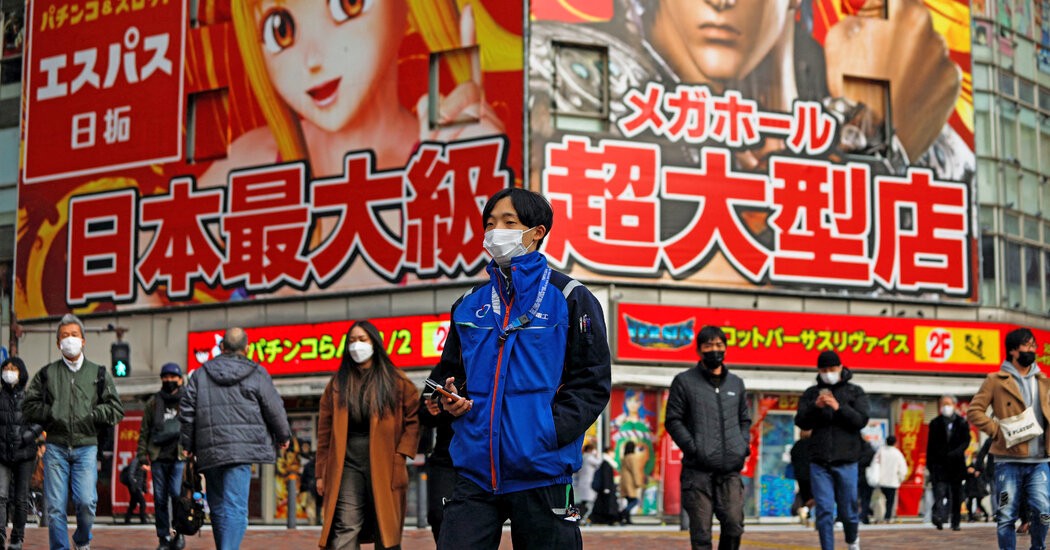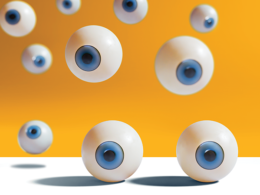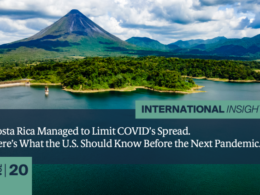Even though over 70 percent of Japanese citizens are fully vaccinated, vaccination alone won’t be sufficient for the world to live with Covid-19.
The message — to avoid the three C’s (which are closed spaces, crowded places and close-contact settings …
was actionable without being alarmist and prescribed a solution that could outlast changing circumstances.
New York Times , Guest essay
By Hitoshi Oshitani
Jan. 24, 2022
Issei Kato/Reuters
Dr. Oshitani is a professor of virology at Tohoku University Graduate School of Medicine in Japan. He has helped advise the Japanese government on its Covid-19 response.
Executive Summary (by the Editor of the blog)
Japan’s approach to Covid-19 has often been misunderstood.
- Some have assumed the country was either doing poorly and hiding it or doing well because of Confucian traditions of people putting community over themselves.
What really happened was that science was used to create an effective strategy and a digestible message.
- That message — to avoid the three C’s (which are closed spaces, crowded places and close-contact settings.) — was actionable without being alarmist and prescribed a solution that could outlast changing circumstances.
The approach in Japan hasn’t been without consequences.
- The economy was affected and people like service industry workers lost jobs as bars and restaurants were avoided.
- Some have suffered mental health challenges brought on by isolation.
Going forward, the Japanese government needs to acknowledge the challenges, improve on them and work to protect the most vulnerable and underserved populations.
But broadly speaking, Japan has weathered Covid-19 well.
- The Japanese people will need to embrace the three C’s whenever there’s a surge.
- This is most likely how we will continue to adapt to life with the virus.
It worked because of an underlying trust between the public and pandemic responders.
- It would require a much deeper analysis to understand how anthropological, cultural and historical contexts have played into the various response measures around the world and their effectiveness.
- But for now, we know that an effective, science-based message has helped Japan keep deaths lower compared to the numbers in peer countries and could be an example of how to move forward in a world where Covid-19 will always be with us.
The Japanese people will need to embrace the three C’s (which are closed spaces, crowded places and close-contact settings.) whenever there’s a surge.

ORIGINAL PUBLICATION (full version)
What Japan Got Right About Covid-19
New York Times , Guest essay
By Hitoshi Oshitani
Jan. 24, 2022
Issei Kato/Reuters
Dr. Oshitani is a professor of virology at Tohoku University Graduate School of Medicine in Japan. He has helped advise the Japanese government on its Covid-19 response.
It all began with the coronavirus outbreak on a Diamond Princess cruise ship back in February 2020.
Nine health care workers and quarantine officers who were responding to the outbreak on the ship in Japan became infected. An official report suggested that they had most likely been infected through contact with infectious droplets and contaminated surfaces. But as an expert investigating respiratory infections, I had my doubts. These were people experienced in infection control and prevention procedures, and it was difficult to believe that not one, not two, but nine of them failed to wash their hands properly. While this was still in the very earliest days of the pandemic, it seemed possible that the coronavirus was spreading in some other way than through large droplets.
Then a report revealed that a traveler from China who visited Germany spread the coronavirus to other people despite not having symptoms at the time.
This report confirmed what I and colleagues helping Japan’s Ministry of Health respond to Covid-19 had speculated: That the coronavirus was being spread by people who were asymptomatic or hadn’t developed symptoms yet.
At that point, we had to consider whether aerosols — tiny infectious particles or droplets suspended in the air — were playing a role in how the coronavirus was spreading.
This wouldn’t be a surprise. In 2017, a World Health Organization report discussed the critical role that aerosol transmission played in the spread of the flu. Why couldn’t it be the same for Covid-19, a similar respiratory illness?
Japan’s unique way of contact tracing also gave us more clues into how the virus spread.
While other countries focused on prospective contact tracing, in which contact tracers identify and notify infected people’s contacts after they are infected, we used retrospective contact tracing.
This is an approach where tracers identify an infected person and look back to figure out when and where that person was infected and who else might have been infected simultaneously with them.
This approach turned out to be critical as we learned that the coronavirus was being spread predominantly by small numbers of infected individuals who then go on to seed super-spreading events.
My research colleague Hiroshi Nishiura calculated that a majority of cases were most likely coming from infected people in closed, indoor environments.
More data from public health centers in Japan confirmed that most Covid-19 clusters occurred in close-contact indoor settings, such as dinners, night clubs, karaoke bars, live music venues and gyms.
This has become common knowledge now, but we knew all of this before the end of February 2020 and before the World Health Organization considered Covid-19 a pandemic. This became the basis of Japan’s strategy going forward and is ultimately what allowed Japan to have one of the lowest death rates among its peer countries.
If SARS-CoV-2, the coronavirus, was being spread by aerosols and people could spread the virus before they developed any symptoms, it meant that Covid-19 was largely invisible and would be extremely challenging to eliminate.
Prior diseases like SARS (caused by SARS-CoV, a related virus), which causes pneumonia in most cases, made it easy to identify patients.
Because this wasn’t the case with SARS-CoV-2, a strategy of containment would be too difficult, and Japan needed to figure out an approach to living with Covid-19.
I suggested a basic concept: People should avoid the three C’s, which are closed spaces, crowded places and close-contact settings.
The Japanese government shared this advice with the public in early March, and it became omnipresent.
The message to avoid the three C’s was on the news, variety shows, social media and posters. “Three C’s” was even declared the buzzword of the year in Japan in 2020.
Although Japan declared certain periods of the pandemic states of emergency, that equated to not much more than strongly worded warnings and some travel restrictions for residents.
(Japan has prohibited foreign tourists from entering the country.)
Drastic measures, such as lockdowns, were never taken because the goal was always to find ways to live with Covid-19. ( Japanese law also does not allow for lockdowns, so the country could not have declared them even if we had thought them necessary.)
The three C’s taught people what to avoid. How they do that may be different, depending on individual circumstances and risk tolerance. Some people may be able to stay home. Others may remain silent on crowded trains as they commute to work to avoid spread. Some people may dine out but avoid sitting immediately across from one another. Most people are likely to continue to mask.
These types of behavioral cues may work better in certain social environments, and Japan has a tendency toward adherence and responding to powerful peer pressure.
Not everyone may agree with preventive measures, but many are reluctant to face the disapproval of their friends and neighbors.
When it comes to the numbers of cases and deaths, Japan has fared well compared to other countries.
It has had about 146 deaths per million people in the pandemic so far. The United States has had about 2,590 deaths per million.
Japan’s approach to Covid-19 has often been misunderstood.
Some have assumed the country was either doing poorly and hiding it or doing well because of Confucian traditions of people putting community over themselves.
What really happened was that science was used to create an effective strategy and a digestible message.
That message — to avoid the three C’s — was actionable without being alarmist and prescribed a solution that could outlast changing circumstances.
It worked because of an underlying trust between the public and pandemic responders.
Our approach hasn’t been without consequences.
Our economy was affected and people like service industry workers lost jobs as bars and restaurants were avoided. Some have suffered mental health challenges brought on by isolation. Going forward, the Japanese government needs to acknowledge the challenges, improve on them and work to protect the most vulnerable and underserved populations.
But broadly speaking, Japan has weathered Covid-19 well.
After a period of low transmission rates, the country is facing an uptick in cases because of Omicron, as are other countries. Even though over 70 percent of Japanese citizens are fully vaccinated, vaccination alone won’t be sufficient for the world to live with Covid-19. The Japanese people will need to embrace the three C’s whenever there’s a surge. This is most likely how we will continue to adapt to life with the virus.
It would require a much deeper analysis to understand how anthropological, cultural and historical contexts have played into the various response measures around the world and their effectiveness.
But for now, we know that an effective, science-based message has helped Japan keep deaths lower compared to the numbers in peer countries and could be an example of how to move forward in a world where Covid-19 will always be with us.
Hitoshi Oshitani is a professor of virology at Tohoku University Graduate School of Medicine in Japan and has helped advise the Japanese government on its Covid-19 response. He researches the epidemiology and control of viral infections, particularly respiratory viruses.
Originally published at https://www-nytimes-com.cdn.ampproject.org on January 24, 2022.












